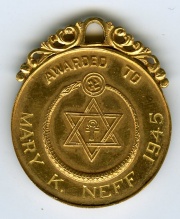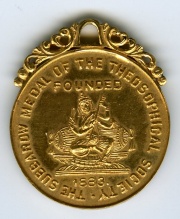Subba Row Medal: Difference between revisions
Jump to navigation
Jump to search
(Undo revision 28591 by Janet Kerschner (talk)) |
No edit summary |
||
| Line 3: | Line 3: | ||
[[File:Subba Row Medal MKN 2.jpg|right|180px|thumb|Reverse side of medal]] | [[File:Subba Row Medal MKN 2.jpg|right|180px|thumb|Reverse side of medal]] | ||
* Aryan Occult Science and Philosophy | * Aryan Occult Science and Philosophy | ||
* Buddhist Esoteric Philosophy | * Buddhist Esoteric Philosophy | ||
* Chaldean Esoteric Science and Philosophy and Zoroastrianism | * Chaldean Esoteric Science and Philosophy and Zoroastrianism | ||
* Jewish Kabbalah and Esoteric Interpretation of the Christian Religion | |||
A fund was established that year to cover the costs of creating a mold and striking the medals. Over the years the medal was no longer awarded for essays, but for major contributions to the body Theosophical literature. The design of the medal shows the Hindu goddess [[Saraswati]] on the reverse side, symbolizing knowledge, arts, and music. | |||
{| class="wikitable" | {| class="wikitable" | ||
Revision as of 15:27, 5 March 2015
In December 27-29, 1883, during the Convention of the Theosophical Society at Adyar instituted the Subba Row Medal, to be awarded to any Theosophical writer producing the best essay on any of the following subjects:
- Aryan Occult Science and Philosophy
- Buddhist Esoteric Philosophy
- Chaldean Esoteric Science and Philosophy and Zoroastrianism
- Jewish Kabbalah and Esoteric Interpretation of the Christian Religion
A fund was established that year to cover the costs of creating a mold and striking the medals. Over the years the medal was no longer awarded for essays, but for major contributions to the body Theosophical literature. The design of the medal shows the Hindu goddess Saraswati on the reverse side, symbolizing knowledge, arts, and music.
Notes
- ↑ Anonymous, "About the Subba Row Medal," Theosophy in Australia 64 (March, 2000), 20.

